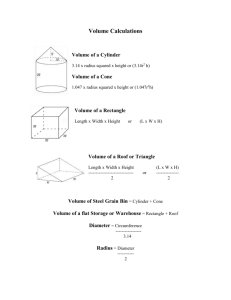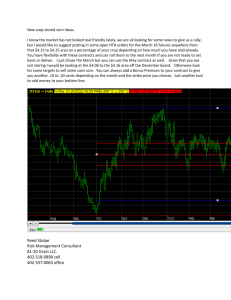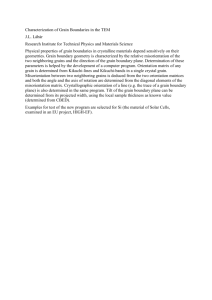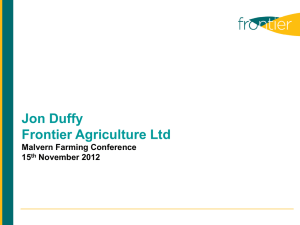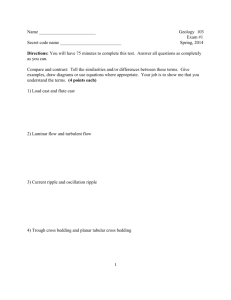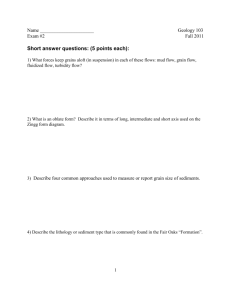Aeration - Stored Grain
advertisement
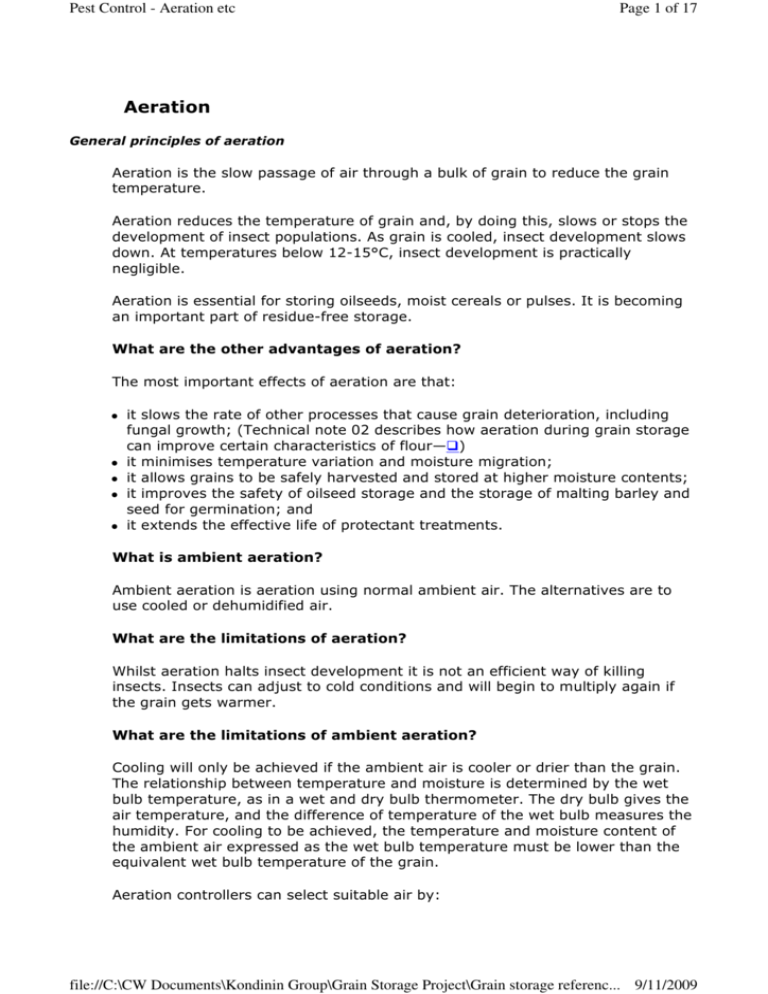
Pest Control - Aeration etc Page 1 of 17 Aeration General principles of aeration Aeration is the slow passage of air through a bulk of grain to reduce the grain temperature. Aeration reduces the temperature of grain and, by doing this, slows or stops the development of insect populations. As grain is cooled, insect development slows down. At temperatures below 12-15°C, insect development is practically negligible. Aeration is essential for storing oilseeds, moist cereals or pulses. It is becoming an important part of residue-free storage. What are the other advantages of aeration? The most important effects of aeration are that: it slows the rate of other processes that cause grain deterioration, including fungal growth; (Technical note 02 describes how aeration during grain storage can improve certain characteristics of flour—) it minimises temperature variation and moisture migration; it allows grains to be safely harvested and stored at higher moisture contents; it improves the safety of oilseed storage and the storage of malting barley and seed for germination; and it extends the effective life of protectant treatments. What is ambient aeration? Ambient aeration is aeration using normal ambient air. The alternatives are to use cooled or dehumidified air. What are the limitations of aeration? Whilst aeration halts insect development it is not an efficient way of killing insects. Insects can adjust to cold conditions and will begin to multiply again if the grain gets warmer. What are the limitations of ambient aeration? Cooling will only be achieved if the ambient air is cooler or drier than the grain. The relationship between temperature and moisture is determined by the wet bulb temperature, as in a wet and dry bulb thermometer. The dry bulb gives the air temperature, and the difference of temperature of the wet bulb measures the humidity. For cooling to be achieved, the temperature and moisture content of the ambient air expressed as the wet bulb temperature must be lower than the equivalent wet bulb temperature of the grain. Aeration controllers can select suitable air by: file://C:\CW Documents\Kondinin Group\Grain Storage Project\Grain storage referenc... 9/11/2009 Pest Control - Aeration etc Page 2 of 17 either measuring air and grain temperature and humidity or combining measurements of the air and grain temperature and air humidity with an input of the known grain moisture content. The controllers can switch aeration fans on and off to achieve the most efficient cooling. If the grain and air temperatures and humidities or moisture contents are known, a psychrometric chart can be used to determine the suitability of the air and the cooling it can theoretically achieve. Ambient air can be cooled or dehumidified for use in aeration. This greatly increases the cost and is used only when the required cooling cannot be achieved with normal ambient air. A psychrometric chart used by AIRAH, the Australian Institute of Refrigeration, Air Conditioning & Heating, Inc., is available from the CSIRO Stored Grain Research Laboratory. (Contact: The Librarian, Stored Grain Resource Centre, CSIRO Entomology. Phone 02 6246 4191.) The psychrometric chart relates dry bulb temperature, moisture content, wet bulb temperature, relative humidity, volume and enthalpy. What equipment is needed for aeration? Aeration requires the following equipment: a fan and duct kit an aeration controller that determines when the fan will be on. (See Industry contacts for suppliers of aeration equipment .) What flow rates should be used for cooling and drying? Maintenance Cooling Aerationdrying Drying 0-0.5 L/sec/tonne (plus fumigation) 0.5 to 2.5 L/sec/tonne for small grains; 2 L/sec/tonne for maize and soybean 2.5 to 20+ L/sec/tonne 5+ L/sec/tonne, max 30 L/sec/tonne Note: 0.05 m³/min/tonne = 1 L/sec/tonne Controllers For aeration to work efficiently, only air of the correct quality should be passed through the grain. The effect of aeration on grain is determined by: file://C:\CW Documents\Kondinin Group\Grain Storage Project\Grain storage referenc... 9/11/2009 Pest Control - Aeration etc Page 3 of 17 • the temperature and relative humidity of the air and • the temperature and moisture content of the grain. Dry bulb controllers are not able to fully assess the heat and moisture components of the input air. They may still be fairly effective controllers if the fans are set to operate only when the air dry bulb temperature falls below the grain temperature by more than a pre-set temperature difference. The CSIRO time proportioning controller changes its thermostat automatically to select the coolest available air. Wet bulb controllers can accurately determine when cooling and/or drying will occur. The selection of controller depends on the climate: • air humidity controllers are most suitable in the tropics • grain wet bulb temperature controllers for warm temperate climates, and • the calendar for cold climates. Manual Controllers The simplest forms of control are: • to manually switch the fans on and off, based on the grain temperature and humidity, and air temperature and humidity • or to control the aeration period with timers or thermostats. Timer control is the least complex and can be used in combination with offpeak power to minimise the cost of cooling of grain. With knowledge of average climatic conditions and grain temperature, a timer can be set periodically to give cooling under average conditions. There will, of course, be times when unsuitable air is blown into the system, thus reducing its efficiency. Timers need to be readjusted frequently to ensure that they are operating at the most favourable time, usually from midnight on. The same is true for thermostat controllers. Automatic Controllers The most complex form of control is by computer-controlled decision-making systems that continuously monitor the ambient and grain conditions. A system is in operation that continuously measures grain temperature, air temperature and air humidity. Using the known grain moisture content, it selects air when the conditions are favourable for aeration. The Stored Grain Laboratory is developing a PMCAM system for farmers which works similarly. Automatic controllers provide economic benefits due to improved efficiency, better grain quality, and reduced supervision. Upward or downward aeration Aeration systems may be either suction (air drawn down through the grain) or pressure (air blown up through the grain). Pressure systems are generally the better choice for use throughout Australia for the following reasons: The warmest grain is located near the surface where it can be easily observed. With suction systems, the warmest grain is deep within the grain mass. file://C:\CW Documents\Kondinin Group\Grain Storage Project\Grain storage referenc... 9/11/2009 Pest Control - Aeration etc Page 4 of 17 If warm air is loaded on top of grain that has already been cooled, warm air is driven upward and not drawn into the cool grain, as it would be with a suction system. The fan will add 1°C–1.5°C of heat to the air, reducing the possibility of rewetting during humid weather. This is of use only in cool climates, as extra air heating is undesirable in hotter regions. Hardware is cheaper and installation simpler. When should aeration be used? Aeration should be used as soon as possible after harvest, as long as the ambient air is suitable. Aeration can be fitted to old and new, sealed or unsealed bins or sheds. Aeration is the only non-chemical system of insect control readily available for unsealed storage structures. It has a potential role in storing of all grains but is particularly valuable in storing oilseeds, over-moisture grain, malting barley and seed for planting. When is aeration impractical? Ambient aeration cannot be used in areas where the ambient air is unsuitable, as, for example, in the humid tropics. Power must also be available. Systems have been developed for dehumidifying air by passage through silica gel which is afterwards dried by the heat of the sun for re-use. For practical information on aeration equipment, see suppliers in the Industry contacts section . Proportioning controller Photograph courtesy of Agridry Rimik Click to return to the Managing pests submenu. file://C:\CW Documents\Kondinin Group\Grain Storage Project\Grain storage referenc... 9/11/2009 Pest Control - Aeration etc Page 5 of 17 file://C:\CW Documents\Kondinin Group\Grain Storage Project\Grain storage referenc... 9/11/2009 Pest Control - Aeration etc Page 6 of 17 Phosphine fumigation General principles of phosphine fumigation Phosphine fumigation in sealed storage The SIROFLO method of fumigation Phosphine dosage rates Technical Note 04, Measuring phosphine concentrations Safe usage and effectiveness file://C:\CW Documents\Kondinin Group\Grain Storage Project\Grain storage referenc... 9/11/2009 Pest Control - Aeration etc Page 7 of 17 General principles of phosphine fumigation For over half a century commercial storage has relied on chemical protection, but phosphine remains almost alone as the effective, cheap solution which is suitable for all levels of storage and leaves no residues when used correctly. Phosphine is produced during the fumigation by the action of water vapour on aluminium phosphide pellets, tablet or powder formulations. The formulation is often called phostoxin, but there are many similar commercial formulations of about 60% aluminium phosphide with 40% inert fillers. (Reference to tablets also applies equally to pellets, bag or blanket formulations.) There is also a 2% mixture of phosphine in carbon dioxide in gas cylinders called ECO2FUME. (The formulations are listed in the table Output of phosphine from various sources below.) How does phosphine work? Phosphine is a slow acting gas which takes several days or more to make a complete kill of all insect stages. Phosphine should not be used as a knock-down agent just to kill adults; instead, it should be used to achieve total kill of all stages. (Refer back to timing the control treatment). Phosphine is a light gas which easily escapes if the silo is not gastight. It can only be properly effective if the fumigation space is fully gastight. (Refer to Silos in the section Structures.) Misuse of phosphine The widely available and inexpensive aluminium phosphide formulations are generally poorly applied without regard to operator safety or to achieving adequate phosphine concentrations. Admixture, the common method of application in unsealed storage by inserting the tablets into the auger stream, is not acceptable. There are three reasons why the admixture method is not acceptable: In unsealed structures, the gas leaks away rapidly at the grain surface due to the action of sun and wind, leaving insufficient gas to kill all the pests. This has enabled survival and the emergence of phosphine resistant strains. Toxic powder residues containing unchanged aluminium phosphide remain in the grain. (The formulation leaves 4% of unchanged residue. At an application rate of 3g/tonne, this leaves a residue of 0.12 mg /kg exceeding the 0.1 mg/kg maximum residue limit.) If grain containing these residues is fed to animals without cleaning, phosphine is released in the animal with adverse, sometimes fatal effects. There have been a number of recent poisoning cases in dairy cows, and residues of phosphine have been found in milk. For this reason admixture of aluminium phosphide formulations is being actively discouraged and may soon be banned in some States. There is also a potential hazard to farm staff who handle fumigated grain containing aluminium phosphide residues. The problem may be worsened by uneven distribution of the tablets and accumulation of residues when a silo is outloaded. file://C:\CW Documents\Kondinin Group\Grain Storage Project\Grain storage referenc... 9/11/2009 Pest Control - Aeration etc Page 8 of 17 What is the attitude of the market to this grain? The market wants lower phosphine residues and it does not accept grain fumigated by admixture as pesticide residue free grain (a classification covered later in this section ). Grain fumigated by admixture just before sale or, worse still, loads fumigated in transit can be hazardous to the receivers. Can grain be fumigated with phosphine in unsealed storage? Generally speaking, the answer is 'no', unless you are using the SIROFLO system. In fumigation, two specific requirements—gas concentration and time—must be met for the fumigation to achieve insect control. The concentration must reach lethal levels in all parts of the silo, and the time must be long enough to allow the more tolerant stages of the insect to move into a susceptible phase . It is not possible to achieve the time component in an unsealed silo and the concentration will be reached only in some parts of the grain bulk. The length of time needed depends on the concentration, temperature, and the method of phosphine distribution. Phosphine fumigation in sealed storage The way to avoid admixture treatment is to use phosphine only in sealed storage. What is meant by sealed storage? Sealed storage means that the silo is totally gastight when closed, so that there is restricted interchange between the inside and outside air. There is more detail on sealed silos in the section Structures . How do I know whether my silos are gastight? Generally the silos must have been manufactured to a gastightness standard. (Silo suppliers will have details; refer to Industry contacts on the sidebar). However, it may be possible to have older silos resealed, depending on the construction. Can the sealing be checked? To determine whether a silo is sufficiently gastight it is necessary to carry out a pressure test. A bin is considered sealed or gastight if, when pressurised to an excess internal pressure, it takes longer than 5 minutes to decrease to half the positive pressure when the pump is switched off. Before starting the test, decide on the upper pressure limit. 500 Pa may be a suitable upper limit but 100 Pa may be as much as some structures can take. file://C:\CW Documents\Kondinin Group\Grain Storage Project\Grain storage referenc... 9/11/2009 Pest Control - Aeration etc Page 9 of 17 Pressure test for gastightness of silo Equipment • a fan giving 3 m³/min at 1000 Pa • stopwatch • pressure gauge (inclined manometer, magnehelic gauge or U-tube manometer), and • plastic hosing with ball valve. Method 1. Connect the fan to the silo through the ball valve and attach the manometer to a suitable port in the silo. 2. Run the fan with the valve open until the pressure difference exceeds the chosen upper pressure limit by 10%. 3. Shut the valve, turn off the fan and measure the time it takes for the pressure to fall from the chosen limit to half the limit. The time should exceed 5 minutes. (No specific pressure test has been set for on-farm storage, and it may be that 2-3 minutes would be adequate.) Pressure testing of a sealed silo is explained in more detail in the section on Bulk storages in Structures . What happens if the silo fails the pressure test? You would only test a silo that is factory or retro-sealed. If a sealed silo fails the pressure test, the leaks must be found by checking leaky joints with soapy water while the pump is still running. Small leaks can be sealed with silicone sealant or tape and defective flanges replaced. Repairs must be continued until the pressure test is successful. Is surface application recommended? Sealed squat bins (height:diameter is not greater than 2:1, that is, those whose height is less than twice their diameter) can be fumigated by applying the complete dosage on the grain surface or in the headspace using recoverable strips, blankets, tablets or pellets. A blanket consists of 100 bags sealed in a paper matrix. Blankets are hung from the top of the silo or laid on the grain surface. Tablets, pellets or bags are put in trays on or above the grain. The gas mixes through the grain by diffusion. After the fumigation, the spent formulation is removed and disposed of. Disposing of spent formulation • Ensure that residual phosphide is destroyed before disposal by swamping with dilute acid or soapy water at a secure open air location away from residential or work areas and sources of ignition. • Stand upwind when wetting the formulation. • For on-site disposal, the destruction of the formulation should be conducted in the disposal pit. file://C:\CW Documents\Kondinin Group\Grain Storage Project\Grain storage referenc... 9/11/2009 Pest Control - Aeration etc Page 10 of 17 • Empty containers should be triple rinsed, punctured, crushed and buried. (Further details are in the Safety section— .) Does this work for tall narrow silos? Fumigation may be carried out by surface application in tall sealed silos (i.e those which are at least twice as high as they are wide) with low flow recirculation. Such recirculation systems use PVC ducting varying from 75 mm to 150 mm. This may be rigid ducting attached to the side of the silo or flexible temporary ducting. Small centrifugal fans of about 0.4 kw are used. Flow rates are around 0.05 m³/s. Blankets are hung from the top of the silo or tablets are put in trays on top of the grain. The emergent gas that forms is pulled down from the top of the silo and pushed up through the grain. The recirculation is continued until there have been at least 2 complete passages of gas through the grain and then the fan is switched off. The fan time is upwards of 12 hours, depending on the silo size and fan capacity. What are the advantages of fumigation in sealed silos? The sealed storage system makes the most effective use of the very cheap aluminium phosphide formulations and allows use of the lowest recommended doses . There is also no need to move the grain into another bin when you want to fumigate it. Is grain fumigated in this way residue free? Grain which is fumigated only by phosphine gas and has no residue of aluminium phosphide in the grain is accepted as being residue free. Can the grain in sealed silos be fumigated with the ECO2FUME formulation? ECO2FUME (a 2% mixture of phosphine in carbon dioxide) can be used in sealed storages with a low flow recirculation system keeping an even concentration in the silo. The gas is easily removed after fumigation by the same recirculation system. With ECO2FUME there is no contact with the phosphine formulation. The gas is, however, much more expensive than the tablets. The SIROFLO method of fumigation What is the SIROFLO method of fumigation? SIROFLO is a method developed in Australia for the Bulk Handling Companies for fumigation in silos which cannot be properly sealed. The method uses the ECO2FUME formulation. A low concentration () of phosphine gas is passed continually through the grain to atmosphere over a much longer period (16-28 days) than that required in normal fumigation. file://C:\CW Documents\Kondinin Group\Grain Storage Project\Grain storage referenc... 9/11/2009 Pest Control - Aeration etc Page 11 of 17 Can a farmer install SIROFLO? SIROFLO can only be used under licence from BOC (Australia) Ltd, PO Box 288, Chatswood, NSW 2057, fax 02 9928 3915, or its agents. Farmers will be required to undertake training in the particular hazards of handling phosphine gas before obtaining a licence to buy the ECO2FUME formulation. What are the disadvantages of using SIROFLO? Use of SIROFLO is much more expensive than aluminium phosphide formulations. It is also necessary to check the level of phosphine in air to ensure the concentration is effective (Measuring phosphine concentration in air is dealt with in Technical Note 04.) This is good practice in any fumigation. It is also necessary to check the levels of phosphine outside the fumigated space to prevent exposure if phosphine leaks from the system. What are the advantages of the SIROFLO method? It can be used in poorly sealed silos. No residues are left in the grain. All fumigation can be done in the single bin. It is easier to fumigate very dry commodities. Phosphine is strongly sorbed onto many commodities, particularly oilseeds, leading to gas concentrations which are too low to be effective. SIROFLO combats the sorption of phosphine on high oil content commodities by continually replenishing the atmosphere at a low concentration. Phosphine ignites if the explosive concentration is reached (about 1.8%). This cannot occur with 2% phosphine in carbon dioxide. Can the SIROFLO low flow method be used in sealed storage? SIROCIRC is a parallel system in which phosphine gas is introduced from cylinders into sealed storages with a low flow recirculation system. This system keeps an even concentration in a single bin or a series of bins. Practical tips on phosphine fumigation in sealed silos Fumigate immediately silo has been filled. Place tablets on trays on top of the grain mass, removing prior to outloading. Prepackaged phosphine (ie blanket formulations) can be placed on top of the grain or hung in the headspace. Remove before outloading. Dosage 1.5 grams per cubic metre capacity of the silo, that is, 2 tablets per tonne wheat capacity of silo. For example, a 56 tonne silo (2000 bushels) will require 112 tablets. The same dose applies whether the silo is full or only partly filled. This is because the phosphine gas has to fill the same amount of space. Exposure time file://C:\CW Documents\Kondinin Group\Grain Storage Project\Grain storage referenc... 9/11/2009 Pest Control - Aeration etc Page 12 of 17 Cereals: Commodity temperature between 15 ° C and 25°C, fumigate for 10 days. Commodity temperature greater than 25°C, fumigate for 7 days. Peas: Commodity temperature greater than 15°C, fumigate for 14 days. Never fumigate if commodity temperatures are less than 15°C. Precautions • Following fumigation, ventilate the silo for a minimum of 5 days and withhold a further 2 days prior to outloading. • When filling, leave at least 10% headspace to allow fumigant to circulate. • Maintain the fluid level in the relief valve. • On outloading, open the top hatch to avoid structural damage. • Do not leave empty silos sealed: open the cone access hatch when the silo is empty. • Place warning signs on silo during the entire fumigation period, and record the date of fumigation on the sign. • Never enter a silo whilst fumigation is in progress—only enter after ventilation is complete. See Updates on the bottom menu bar to locate suppliers of fumigation equipment Table: Output of phosphine from various sources Weight of formulation Tablet, 3 g Output of phosphine 1g Pellet, 0.6 g 0.2 g Bags, 11 g each Blankets G size cylinder 11 g 1.1 kg 31 kg (as 2 % phosphine in C02) Phosphine dosage rates Table: Phosphine dosages recommended in Australia for gastight structures Formulation Rate per m³* Minimum period Tablets (1g PH3) 1.5 tablets** 7 days Pellets (0.2g PH3) 7.5 pellets** 7 days Blanket (1.1 kg PH3) 1 per 1000 m³ >10 days * calculated on whole structure, filled or partly filled file://C:\CW Documents\Kondinin Group\Grain Storage Project\Grain storage referenc... 9/11/2009 Pest Control - Aeration etc Page 13 of 17 **equivalent to 2g/tonne Source: Australian Agricultural and Veterinary Chemicals Council 1992, PB441 Phosphine Generating Products—Guidelines for Use. Table: Effect of phosphine sorption—Commodity dosage factors to be applied to phosphine application rates when fumigating different commodities Commodity Commodity dosage factor Low sorption: Wheat, barley, milled rice, maize, sorghum, chickpeas seeds, milled grain x1 Moderate sorption: Oats, soybeans, canola, safflower, field peas x2 High sorption: Paddy, sunflower, peanuts x3 Very high sorption: Linseed, cottonseed, safflower do not fumigate Source: Winks, R.G. (CSIRO Entomology, SGRL) 1990, draft supplement to Suggested Recommendations for the Fumigation of Grain in the Asean Region, vols 1 & 2, AFHB and ACIAR. Table: Phosphine dosage rates for SIROFLO and SIROCIRC Rates currently in use in Bulk Handling vary from 40 to 70 ppm for 15 to 28 days. Advice should be sought. 70 ppm approximately equals 0.1 g/m³ Adapted from Australian Agricultural and Veterinary Chemicals Council 1992, PB441 Phosphine Generating Products—Guidelines for Use. Safe usage and effectiveness Is phosphine flammable? Phosphine is spontaneously flammable (self-igniting) if it reaches a critical concentration (about 1.8% or 18000 ppm v/v at normal pressure). The gas given off from the tablet or powder formulation must be allowed to mix with grain or an adequate headspace in the silo. Ignition sometimes occurs when tablets are opened and is caused by gas build-up in the package. This is not dangerous if the package is pointed away from the body when it is being opened. The 2% phosphine in carbon dioxide mixture cannot explode. Is phosphine adequately labelled? file://C:\CW Documents\Kondinin Group\Grain Storage Project\Grain storage referenc... 9/11/2009 Pest Control - Aeration etc Page 14 of 17 It is essential that all farmers read the label on all crop protection chemicals. However, the current label is cluttered and needs revision with regard to rates for unsealed storage and ventilation requirements. Also the TWA-TLV (threshold limit value for continuous exposure in the workplace) is not given. (See the section on safety—). What is the current attitude to SIROFLO in the Central Handling system? The Bulk Handling Companies have been very committed to the use of SIROFLO and it has been the main pest control method in unsealed storage for many years. However, due to recent increases in resistance, the dosage rate for SIROFLO has been increased to 70 ppm and this has increased the cost to 30-40 cents per tonne. Fumigant losses and uneven distribution have also reduced the effectiveness. As a result some companies are looking to seal some of the older silos and reduce their dependence on the SIROFLO method. Is it dangerous to be exposed to phosphine? Phosphine is very toxic to mammals, although short low level exposures are not thought to cause long term health hazards. A protective mask with the correct filter must be available when phosphine fumigation is being carried out and should be worn when fumigant is being applied. In serious cases of exposure, such as when there is a need to enter a fumigated area, then a self-contained breathing apparatus should be used. It is good practice to monitor the atmosphere when applying phosphine in confined spaces and from gas cylinders. (Also see the section on safety—). More details are given in Technical Note 04. Why is the length of the fumigation period critical for the success of phosphine fumigation? Pre-adult insect stages must have time to develop into the more easily killed adult insects for effective fumigation. What is the effect of temperature on the exposure time? At higher temperatures, exposure time can be shorter as insect development time is shorter. Market standards on residues Pre-harvest residues Post-harvest residues Technical Note 05: Sampling for residue tests Pesticide residue-free grain file://C:\CW Documents\Kondinin Group\Grain Storage Project\Grain storage referenc... 9/11/2009 Pest Control - Aeration etc Page 15 of 17 file://C:\CW Documents\Kondinin Group\Grain Storage Project\Grain storage referenc... 9/11/2009 Pest Control - Aeration etc Page 16 of 17 Pre-harvest residues In cereal production a variety of insecticides, fungicides, herbicides and nematicides may be used to protect the growing plant. In most cases the preharvest use of the chemical should not result in any measurable residue in the cereal after harvest. Vendors may be asked to complete the NACMA Commodity Supplier Declaration Form. To see or print a copy of the NACMA Declaration Form, go to the Document Reader . Some grain buyers require zero residues of pre-harvest pesticides. This should not be a problem if you have followed the label instructions on time of application and withholding periods. Every pesticide used in the pre-harvest production of cereal crops must have a maximum residue limit for the cereal. In most cases, but not always, this limit is set at the limit of detection, effectively zero. Countries which require analysis for pre-harvest residues may set their own limits of detection, but these are usually similar to the international Codex limits . Checking for pre-harvest residues is expensive and is usually at the buyer's expense. Click to return to the Market standards submenu. Post-harvest residues When grain is to be stored, it may be sprayed with an insecticide which creates a residue that protects the cereal for the storage period. Grain treated in this way cannot afterwards be offered as pesticide residue-free grain. Treated grain must satisfy different residue limits depending on the demands of individual markets. Specific limits are placed by the brewing industry, the starch gluten industry, the Australian Lotfeeders Association, the dairy industry and by many individual overseas buyers. For outlets which accept Codex limits, residues at the time of sale must be less than the Codex and Australian limits. The buyer may ask for certification of the pesticide used, for example on the NACMA Commodity Supplier Declaration Form and a residue test result—for more details see Sampling for residue tests. The test for post-harvest residues will be much cheaper than a test for pre-harvest residues and may be at the seller's expense. Click to return to the Market standards submenu. Pesticide residue-free grain Pesticide residue-free (PRF) grain is grain which has been grown with normal file://C:\CW Documents\Kondinin Group\Grain Storage Project\Grain storage referenc... 9/11/2009 Pest Control - Aeration etc Page 17 of 17 pesticide use, but stored without the use of post-harvest pesticides. Grain which has been grown without the use of pre-harvest pesticides is called organic grain. Grain which is pesticide residue-free is not restricted in any market, but proof may be required that there are no detectable residues of pre-harvest chemicals. Grain fumigated with phosphine by circulation of phosphine gas or by placing aluminium phosphide tablets, pellets, bags or blankets on trays above the grain surface is defined as pesticide residue-free. However, the grain cannot be described as pesticide residue-free if aluminium phosphide formulations have been admixed with the grain. We now turn to control treatments for organic grain. Click to continue. file://C:\CW Documents\Kondinin Group\Grain Storage Project\Grain storage referenc... 9/11/2009
